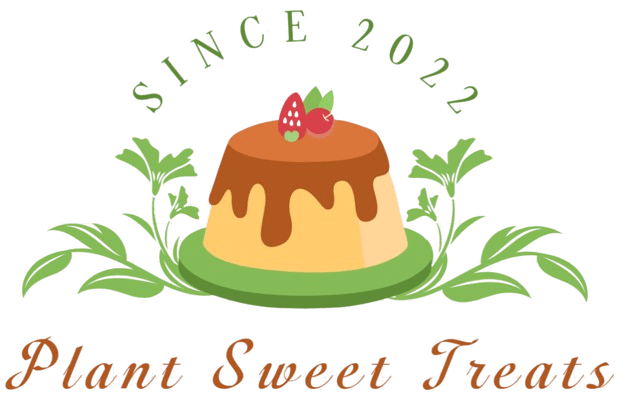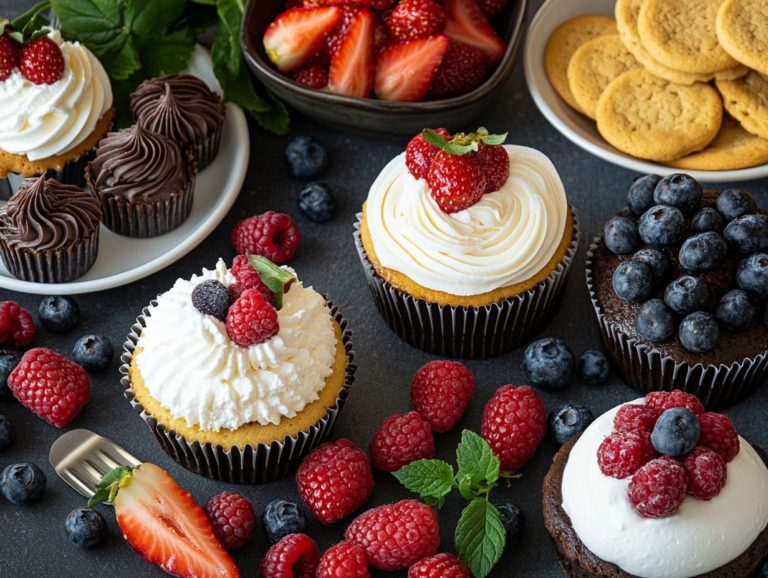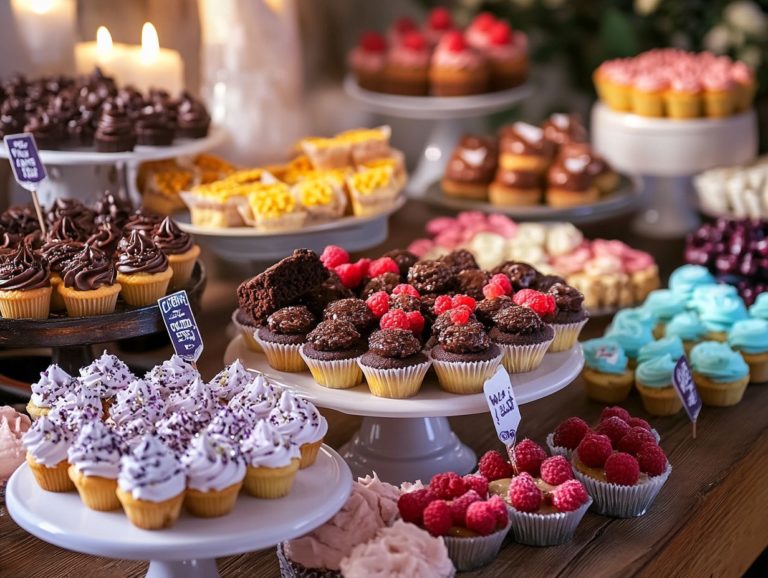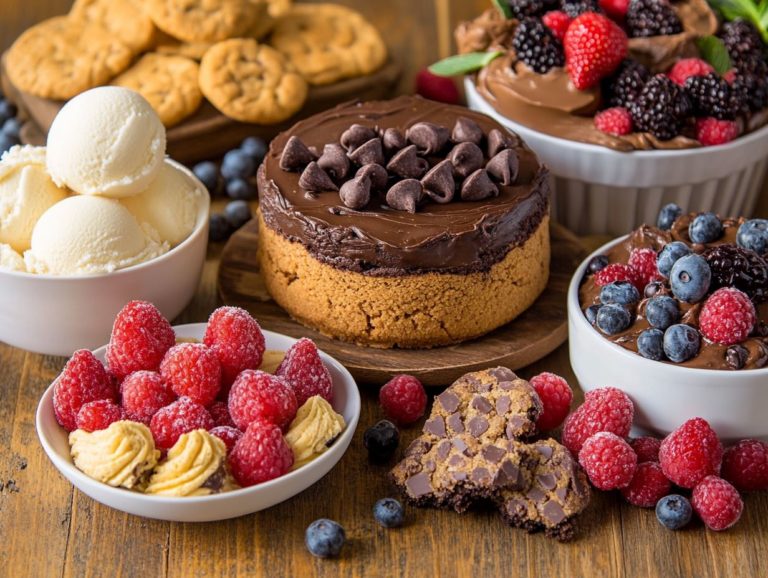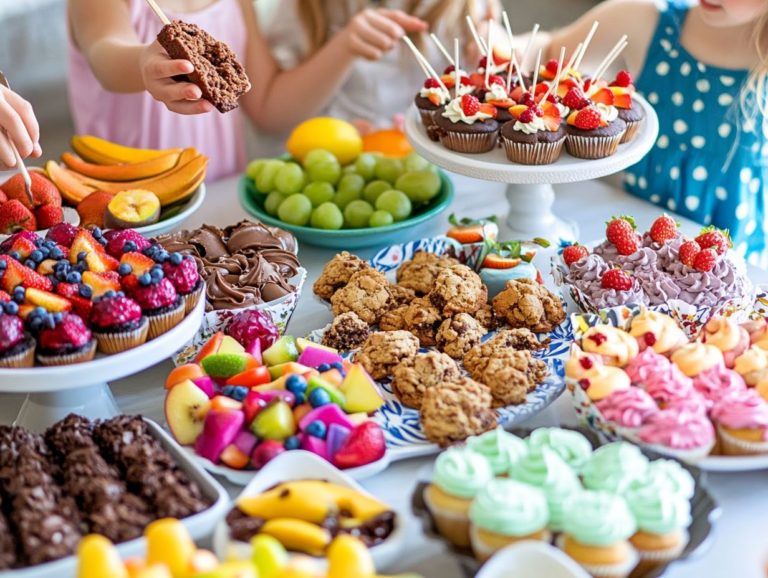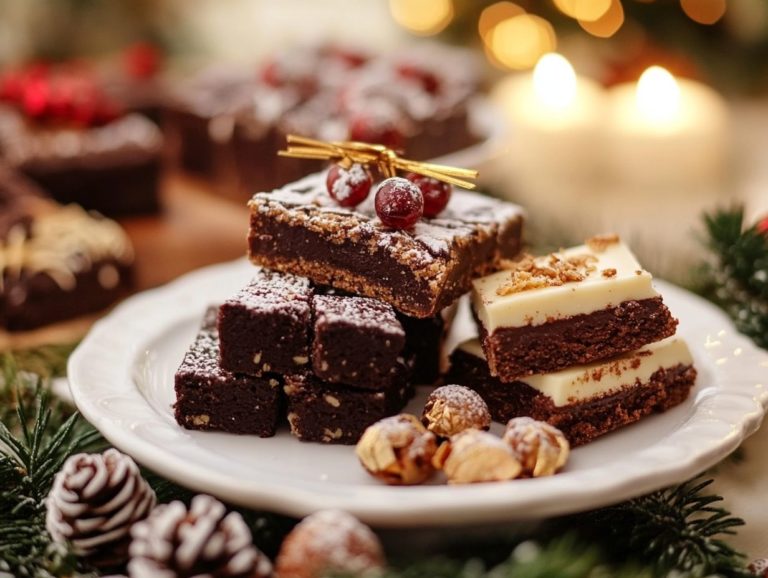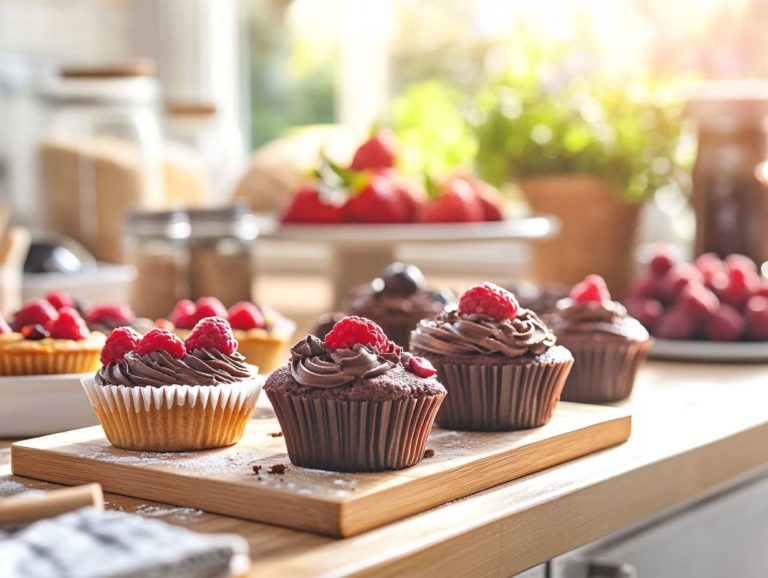The Science Behind Gluten-Free Baking
Gluten has transformed into quite the buzzword lately, frequently linked to dietary restrictions, gluten sensitivities, and various health concerns.
But what is gluten, and why do some individuals opt to steer clear of it? This article delves into the science behind gluten, exploring conditions such as celiac disease and non-celiac gluten sensitivity.
It also highlights the essential role gluten plays in baking and outlines how gluten-free baking differs from traditional methods, along with the gluten-free flours and ingredients required to create delectable gluten-free treats.
You will find valuable tips and ideas for successful gluten-free baking. Anyone can easily try these methods at home!
Contents
- Key Takeaways:
- What is Gluten and Why Do Some People Avoid It?
- How Does Gluten Affect Baking?
- What Ingredients are Used in Gluten-Free Baking?
- What Are Some Tips for Successful Gluten-Free Baking?
- Introduction to Gluten-Free Baking
- What Are Some Common Gluten-Free Baked Goods?
- Frequently Asked Questions
- What is gluten and why is it problematic for some people?
- How does gluten affect the baking process?
- What are the main challenges of gluten-free baking?
- What ingredients are commonly used in gluten-free baking techniques?
- How does the science behind gluten-free baking differ from traditional baking techniques?
- Are there any additional factors to consider when creating gluten-free recipes?
Key Takeaways:
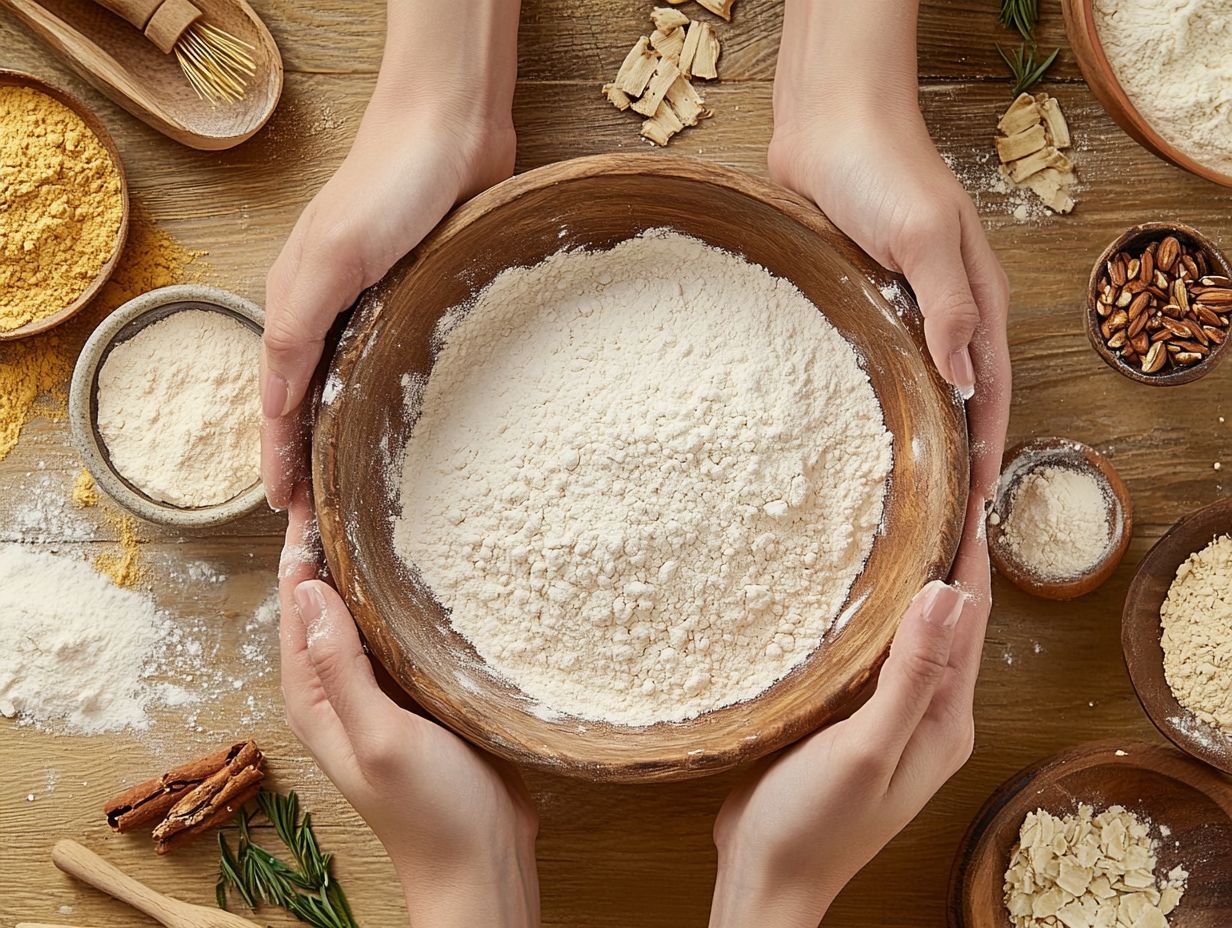
- Gluten is a protein found in wheat, barley, and rye that can cause health issues for some people, such as celiac disease or non-celiac gluten sensitivity.
- In baking, gluten gives dough its elasticity and helps it rise. Gluten-free baking requires alternative ingredients, such as gluten-free flour substitutes, binders like xanthan gum and guar gum, and chemical leavening agents such as baking powder and baking soda.
- To successfully bake gluten-free, precise measuring, using gums like xanthan or guar, and experimenting with different flours such as almond flour, coconut flour, rice flour, and tapioca starch are key. Common gluten-free baked goods include bread, cookies, cakes, and pastries.
What is Gluten and Why Do Some People Avoid It?
Gluten, a protein present in wheat, rye, and barley, lends bread its delightful elasticity and chewy texture. However, many individuals choose to avoid gluten due to a variety of health concerns, especially those connected to celiac disease or non-celiac gluten sensitivity.
Avoiding gluten is crucial for health. It can cause serious reactions in individuals sensitive to it, including those with celiac disease or non-celiac gluten sensitivity.
What is Celiac Disease?
Celiac disease is an autoimmune condition where the ingestion of gluten causes damage to the small intestine, disrupting nutrient absorption and leading to a variety of symptoms, including digestive issues, fatigue, and skin problems.
If you’re navigating this condition, you may also encounter additional symptoms such as joint pain, headaches, and mood disturbances. It is crucial to recognize the signs early.
Diagnosis typically involves blood tests. This is followed by a biopsy of the small intestine, underscoring the necessity of a strict, lifelong gluten-free diet.
Complying with this diet is essential; it not only alleviates symptoms but also helps prevent serious complications like osteoporosis and certain cancers. For those embarking on a gluten-free lifestyle, mastering gluten-free baking techniques and making informed food choices are vital steps to ensure your nutritional needs are met and your overall well-being is maintained.
What is Non-Celiac Gluten Sensitivity?
Non-celiac gluten sensitivity is a condition where you might experience symptoms akin to those of celiac disease after consuming gluten, yet without the autoimmune response or intestinal damage that characterizes celiac disease.
This condition can present a range of distressing symptoms, including bloating, abdominal discomfort, fatigue, and even headaches. It can be quite challenging for those affected. Diagnosing non-celiac gluten sensitivity typically involves a process of elimination, where healthcare professionals rule out other gastrointestinal conditions. You may find yourself monitoring your symptoms in relation to gluten consumption as part of this process.
As awareness of this sensitivity increases, many individuals are gravitating towards gluten-free dietary choices. This contributes to the burgeoning trend of gluten-free products in both baking and cooking. This shift is more than just a response to sensitivity; it s a chance to explore a vibrant new lifestyle with delicious options!
The rise of gluten-free substitutes has truly transformed the culinary landscape, making it easier for those with gluten sensitivity to indulge in a rich and varied diet.
In conclusion, exploring gluten-free options can enhance your culinary experience while maintaining your health. With the right techniques and ingredients, you can create delightful gluten-free recipes that satisfy your cravings.
How Does Gluten Affect Baking?
In traditional baking, gluten is essential, offering the structure and elasticity that dough requires to create that perfect crumb texture in bread and other baked delights. Gluten also plays a key role in creating the desired sensory properties of baked goods.
However, when it comes to gluten-free baking, you must explore alternative ingredients and techniques to replicate these crucial properties and ensure your results are just as satisfying.
The Role of Gluten in Baking
Gluten is essential in traditional baking, providing the dough with the elasticity and strength it needs to rise and hold its structure during the baking process. This directly influences the texture, flavor, and overall sensory properties of the final product you enjoy.
When you combine flour with water, the gluten proteins, primarily glutenin and gliadin, start to interact, forming a network that captures the air bubbles produced by yeast or other leavening agents. This interaction not only supports the dough’s rise but also lends it a chewy consistency and delightful springiness.
The absorption of water and gluten development are crucial in baking. As you knead the dough, those gluten strands become stronger and more organized, enhancing the overall mouthfeel of your baked goods.
This gluten network is crucial for the sensory experience, significantly contributing to the texture and enjoyment of products like bread, pastries, and cakes.
Differences Between Gluten-Free and Traditional Baking
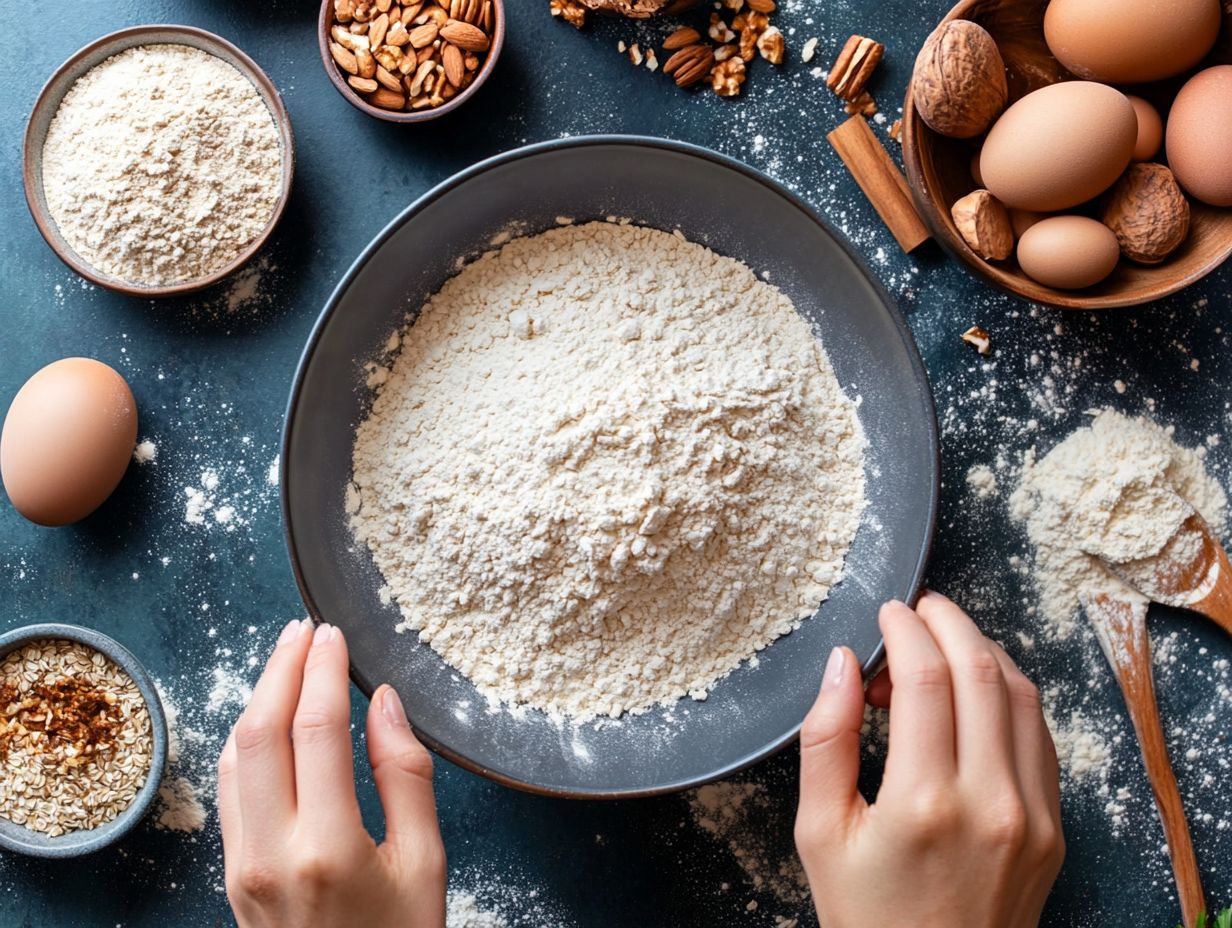
Gluten-free baking sets itself apart from traditional baking in profound ways, necessitating a careful mix of gluten-free flours and other ingredients to replicate the desired textures and flavors. You ll often find yourself reaching for chemical leavening agents like baking powder and baking soda to achieve the leavening effect that gluten typically provides.
Proper hydration control and understanding baking science are also crucial for successful gluten-free baking. The world of gluten-free flours is diverse, featuring options like almond, coconut, rice, and oat flour, each contributing its own unique flavors and textures to your creations.
For instance, almond flour not only imparts moisture but also adds a delightful nutty flavor, while coconut flour lends a light and airy quality to your baked goods. However, simply swapping in these flours won t cut it; they behave quite differently in recipes.
This is where binders such as xanthan gum or guar gum come into play. These binders help mimic the texture gluten usually provides. Adjusting your baking techniques becomes essential; for example, gluten-free batters often benefit from longer resting times or increased liquid to ensure adequate hydration and structure.
By making these adjustments, such as optimizing moisture levels and experimenting with cooking techniques, you can lead yourself to a successful and satisfying baking experience!
What Ingredients are Used in Gluten-Free Baking?
In gluten-free baking, you ll find that a diverse array of alternative ingredients is essential for achieving delicious results. Embrace gluten-free flours like rice, potato, and tapioca starch, which serve as the foundation for your creations.
Don t forget to incorporate binders such as xanthan gum to ensure your baked goods hold together beautifully. This allows you to craft successful treats without a hint of gluten. Don t miss out on the chance to explore these unique flours for an unforgettable baking experience!
Flour Substitutes
In gluten-free baking, you have a delightful array of flour substitutes at your disposal, including rice flour, potato starch, tapioca starch, almond flour, and coconut flour. Each option brings its own distinct flavor and texture to your baked creations.
These alternatives open the door to a world of textures and tastes, making them perfect for anyone looking to reduce or eliminate gluten from their diet. For example, almond flour lends a lovely nutty flavor and moisture to your recipes, while coconut flour adds a touch of sweetness and is a moisture sponge, meaning you’ll need to adjust your liquid ratios accordingly.
On the flip side, tapioca and potato starch work wonders in giving your cakes and pancakes a light, airy quality, but be cautious using too much can result in a gummy texture. The magic happens when you combine these flours thoughtfully; for instance, mixing rice flour with almond flour can strike the right balance of flavor and structure in your baked goods.
Binders and Thickeners
Binders and thickeners, like xanthan gum and guar gum, are essential in gluten-free baking. They help replicate the elasticity and structure that gluten typically provides, ensuring that your final product has the delightful texture you desire.
These ingredients are pivotal in maintaining the integrity of your gluten-free recipes, especially when it comes to striking the right balance of moisture and elasticity. Generally, you’ll want to use about 1 teaspoon of xanthan gum per cup of gluten-free flour; with guar gum, you might lean towards a slightly higher amount, around 1 to 2 teaspoons. Additionally, understanding the role of hydrocolloids can further enhance your gluten-free baking skills.
To optimize hydration control and achieve the best dough elasticity, it s crucial to experiment with different combinations of binders and adjust your liquid ratios accordingly. Allowing the dough to rest can significantly enhance the binding properties and overall quality of your baked goods, resulting in a more enjoyable final product. Utilizing sourdough starters in gluten-free recipes can also provide a unique flavor and texture enhancement.
Leavening Agents in Gluten-Free Baking
Leavening agents such as baking powder, baking soda, and other chemical leavening agents are essential in gluten-free baking, providing the essential rise and lightness that baked goods typically achieve through gluten.
To achieve the best results, it s crucial for you to understand how these agents function and how they can be effectively combined with other gluten-free ingredients. For example, when utilizing baking powder, which often includes an acid, balancing moisture levels becomes paramount; too much liquid can sabotage the rising process. You might consider incorporating ingredients like yogurt or vinegar to amplify the effectiveness of baking soda, resulting in a delightful lift.
Additionally, understanding the role of hydrocolloids like xanthan gum in improving the crumb texture can significantly enhance your baking.
By experimenting with a variety of flours, such as almond, coconut, or rice flour, while ensuring proper hydration control, you can replicate the texture of traditional baked goods. Just remember that you may need to tweak the ratios for different flour types to achieve that perfect consistency.
What Are Some Tips for Successful Gluten-Free Baking?
Achieving success in gluten-free baking demands your unwavering attention to detail and a commitment to specific techniques. You’ll need to master precise measurements, control hydration levels, and skillfully incorporate a variety of gluten-free flours, binders, and hydrocolloids like guar gum.
This meticulous approach will help you attain the ideal texture and flavor in your baked creations.
Introduction to Gluten-Free Baking
Gluten-free baking can be a delightful adventure filled with unique flavors and textures. By mastering the right techniques and understanding ingredient properties, you can create scrumptious baked goods that everyone can enjoy.
Measure Ingredients Precisely
Measuring ingredients with precision is essential in gluten-free baking. Even the slightest variations can profoundly affect the final product s texture, flavor, and overall success.
To achieve accuracy, using kitchen scales for weight measurements is highly recommended. Gluten-free flours can vary significantly in density; thus, a cup of one type may not weigh the same as a cup of another. This variability can lead to inconsistencies in your recipes, resulting in baked goods that are either too crumbly or excessively dense. Incorporating potato starch or tapioca starch can help achieve the right consistency.
It s equally important to consider adjustments when adding other ingredients, such as liquids or leavening agents. These components play a crucial role in achieving the desired outcome. For anyone embarking on the journey of gluten-free baking, mastering the art of adapting measurements and understanding the properties of different flours is vital for creating delectable and successful baked delights.
Use Xanthan Gum or Guar Gum
In gluten-free baking, incorporating xanthan gum or guar gum as a binder is vital for enhancing the elasticity of your dough. These ingredients help your dough stretch like traditional gluten dough, achieving a stable structure in your baked creations.
These binders also assist in mimicking the chewy texture typically associated with gluten-based products, helping you create a satisfyingly delightful mouthfeel. While many bakers suggest using around 1 teaspoon of xanthan or guar gum per cup of gluten-free flour, you might need to experiment to find the perfect amount based on your specific recipe and the other ingredients at play.
When you combine these binders with a variety of flours, starches, and liquids, you improve viscosity while enhancing moisture retention. This leads to a wonderfully soft crumb. They can elevate the overall quality of your baked goods by preventing crumbling an all-too-common issue in gluten-free recipes ensuring a more enjoyable eating experience.
Experiment with Different Flours
Experimenting with different gluten-free flours can lead to delightful flavor enhancements and improvements in texture. This allows you to uncover unique combinations that elevate your recipes.
Whether it s the nuttiness of almond flour, the lightness of coconut flour, or the subtle sweetness of oat flour, each type brings its own character to the table. These flours not only contribute distinct tastes but also significantly influence the moisture, hydration, and density of your baked goods.
As you embark on this culinary adventure, you may discover that embracing these gluten-free alternatives opens the door to innovative creations that both delight the palate and satisfy dietary needs.
What Are Some Common Gluten-Free Baked Goods?
In terms of gluten-free baked goods, you have a delightful array of options at your fingertips. This includes gluten-free bread, cookies, cakes, and pastries. Each of these treats demands careful selection of ingredients and precise baking techniques, along with an understanding of baking science, to achieve the perfect result.
With attention to detail, you can create mouthwatering gluten-free delights that satisfy every craving.
Start experimenting today and discover the joy of creating delicious gluten-free treats!
Gluten-Free Bread
Ingredients
- 1 cup almond flour
- 1/2 cup rice flour
- 1/2 cup sorghum flour
- 1 tsp baking powder or yeast
- 1 tsp xanthan gum or psyllium husk
- 1 cup water (or as needed)
Instructions
Creating gluten-free bread can be a bit of a challenge since gluten is off the table. However, with the right combination of gluten-free flours and baking techniques, you can achieve a satisfying texture and flavor.
Start by carefully selecting your flours almond, rice, or sorghum each of which brings unique characteristics to your dough. Pay close attention to hydration; gluten-free flours absorb moisture differently, so getting the liquid just right is key to creating a balanced mixture.
Leavening agents like baking powder or yeast are your allies in achieving that coveted rise and airy structure.
For optimal results, consider incorporating xanthan gum (a thickening agent derived from bacteria) or psyllium husk to enhance binding. In terms of storage, keep your gluten-free bread in an airtight container at room temperature. Alternatively, you can slice it and freeze it for longer freshness.
Understanding the role of sourdough starters can also provide a unique flavor and texture to your gluten-free bread. Indulge in your warm, fresh-out-of-the-oven bread for an utterly delightful experience!
Gluten-Free Cookies
Ingredients
- 1 cup almond flour
- 1/2 cup coconut flour
- 1/2 cup rice flour
- 1/2 cup sugar
- 1/2 cup butter or coconut oil
- 1 egg
- 1 tsp xanthan gum
- 1 tsp vanilla extract
- Optional: citrus zest or spices
Instructions
You can create gluten-free cookies using a delightful array of gluten-free flours and ingredients, opening the door to a world of flavors and textures that can rival even the most beloved traditional cookies.
Consider incorporating alternative grains like almond flour, coconut flour, or rice flour; they not only introduce unique tastes but also enhance the nutritional value of your treats.
To achieve that perfect texture, it s essential to use binders such as xanthan gum or flaxseed meal, which mimic the elasticity that gluten usually provides.
Don t hesitate to experiment with flavor enhancements like a splash of vanilla extract, a hint of citrus zest, or a dash of your favorite spices to elevate your cookies’ sensory experience. Baking techniques matter too. Adjusting the oven temperature or chilling the dough before baking can greatly influence the final result, ensuring your gluten-free cookies come out just the way you like them crispy or chewy, it s all up to you.
Gluten-Free Cakes
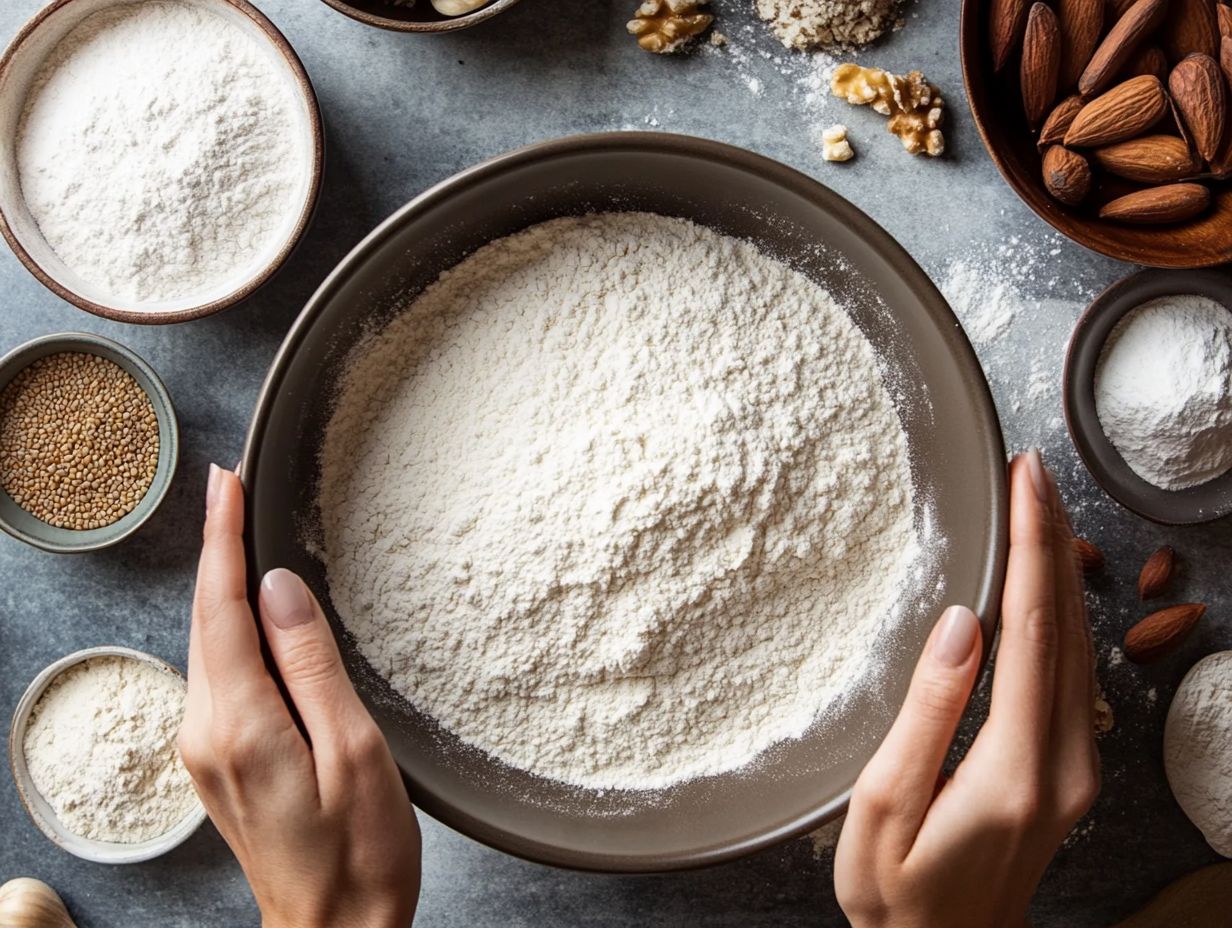
Ingredients
- 1 cup almond flour
- 1/2 cup coconut flour
- 1 cup gluten-free flour mix
- 1 tsp baking powder
- 1 cup sugar
- 1/2 cup butter
- 2 eggs
- 1 tsp vanilla extract
- Optional: citrus zest or aromatic spices like cinnamon
Instructions
Creating gluten-free cakes demands your careful attention to moisture levels and the perfect blend of gluten-free flours and binders to achieve that light, fluffy texture that gluten normally provides.
As you embark on your gluten-free baking journey, it’s crucial to experiment with a variety of flour options like almond flour, coconut flour, or a blended gluten-free mix. Each of these flours brings its own unique flavors and textures, enhancing your culinary creations.
Incorporating binders such as xanthan gum or psyllium husk can effectively mimic the structure that gluten typically offers.
To elevate the flavor profile of your cakes, don’t hesitate to add a splash of vanilla extract, a hint of citrus zest, or aromatic spices like cinnamon. These ingredients will transform your cake into a delightful experience for the palate.
For visual appeal, consider finishing your cake with a simple glaze or a light dusting of powdered sugar. Fresh fruits, edible flowers, or even flavor enhancements like ground nuts can also add a vibrant touch, making your presentation as enticing as the flavors within.
Gluten-Free Pastries
You can create gluten-free pastries using alternative flours and ingredients that offer a deliciously flaky texture, but be prepared for some different baking techniques compared to traditional pastries.
As you embark on your gluten-free baking journey, selecting the right flour is paramount. Options like almond, coconut, or rice flour can significantly influence both the texture and flavor of your final creation. Achieving that perfect crust might pose a challenge, given that gluten-free dough often lacks the necessary elasticity. A reliable solution is to incorporate binding agents such as xanthan gum or flaxseed meal, which can help replicate the structure that gluten usually provides.
In terms of fillings, don t hesitate to explore a variety of flavor combinations. Fruit purees or rich chocolate ganache can truly elevate your pastries. Just remember, managing baking times and temperatures is key to achieving that delightful, golden finish that rivals any gluten-laden treat.
For a smoother consistency, you can also consider using various starches like potato starch or tapioca starch in your pastry dough.
Frequently Asked Questions
What is gluten and why is it problematic for some people?
Gluten is a protein found in wheat, barley, and rye. It is responsible for giving bread and other baked goods their elastic texture. For people with celiac disease or gluten sensitivities, consuming gluten can lead to digestive issues and other health problems.
How does gluten affect the baking process?
Gluten plays a crucial role in baking by providing structure and elasticity to doughs and batters. It helps trap air bubbles created by leavening agents, which gives baked goods their rise and chewy texture. In gluten-free baking, understanding the properties of alternative flours, binders, and the science behind baking is essential to replicate these characteristics.
Gluten, primarily found in wheat, rye, and barley, is essential for creating structure and texture in baked goods. It helps to trap air bubbles, giving bread its rise and pastries their flaky texture. When removed from a recipe, it can be challenging to achieve the same results, especially for those with gluten sensitivities or celiac disease.
What are the main challenges of gluten-free baking?
Gluten-free baking presents several challenges, including the lack of structure and dough elasticity provided by gluten. Other issues include dry and crumbly textures, and difficulty achieving a rise in baked goods, often due to the absence of chemical leavening agents like baking powder and baking soda.
What ingredients are commonly used in gluten-free baking techniques?
There are many different ingredients used in gluten-free baking, including alternative flours such as rice flour, almond flour, coconut flour, and potato flour. Binders such as xanthan gum, guar gum, and psyllium husk are also commonly used to replace the binding properties of gluten, along with other hydrocolloids.
How does the science behind gluten-free baking differ from traditional baking techniques?
In traditional baking, gluten is the key protein responsible for creating structure and texture. In gluten-free baking, alternative methods and ingredients must be used to achieve similar results. This involves a deeper understanding of the different properties of alternative flours like tapioca starch and potato starch, as well as binders and their roles in baking science.
Are there any additional factors to consider when creating gluten-free recipes?
Yes, there are a few additional factors to consider when baking gluten-free. For example, gluten-free flours tend to absorb more moisture, so hydration control is crucial, and recipes may need to be adjusted accordingly. It is also important to avoid cross-contamination when using shared kitchen equipment and tools. Additionally, using eggs, water, and sourdough starters can help improve moisture levels and sensory properties in gluten-free recipes.
